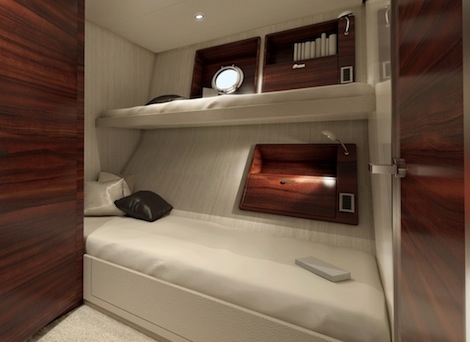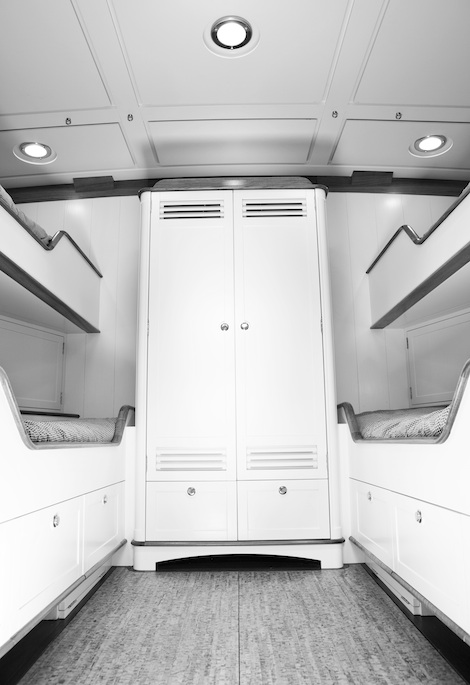MCA allows twin cabins on yachts over 3,000gt
The MCA has accepted a SYBAss application for substantially equivalent twin cabin options for crew on yachts between 3000 and 5000gt. This is a response to the LY3's condition that all seafarers must have single cabins, which SYBAss and the MCA believe would result in minimum-MLC-standard cabins.…
Version three of the Large Commercial Yacht Code (LY3) includes the substantial equivalent accommodation regulations for the Maritime Labour Convention 2006 (MLC). Though the substantial equivalents outlined are lengthy, for yachts of 3000gt or more, the LY3 directs its readers back to the MLC and indicates that after the Convention comes into force, vessels should comply with the full requirements of standard A3.1 of the Convention. Standard A3.1 9(a) states: “In ships other than passengers ships, an individual sleeping room shall be provided for each seafarer”.
The substantial equivalents put to the MCA by SYBAss on behalf of its members outline the fact that a single cabin for all seafarers would likely result in the meeting of minimum MLC standards – something that we should avoid at all costs, especially when current level of superyacht crew accommodation are, in most cases, fairly good.
“It is clear from our studies that large yacht crewmembers would not benefit from the application of this single cabin rule in our sector of the industry,” explained Chris van Hooren, SYBAss technical director. “To reduce the considerable economic impact of single cabins, yacht designers would likely opt for minimum MLC-standard cabins. On board yachts over 3000gt, such cabins would have awkward dimensions with recessed bunks and no en-suite facilities. This would actually lead to crew having lower standards of comfort than is currently the case on superyachts.”
SYBAss’ application for a substantially equivalent twin-cabin option for seafarers on board LY3 yachts over 3000gt is conditional on minimum size and provision of en-suite facilities. The MCA has accepted this and it will be included as part of the UK’s MLC implementation package.
Mark Towl, vessel policy manager at the MCA, shared the view of Van Hooren when he told SuperyachtNews: “The MCA are very pleased to have agreed to a substantially equivalent standard for the use of twin cabins on Large Commercial Yachts between 3000gt and 5000gt. We believe that these standards will provide a better standard of accommodation for crew than would be required by compliance with the minimum MLC requirements, and that they help towards securing the future viability of building yachts over 3000GT.”
But for seafarer union Nautilus International – member of the tri-partite UK working group in conjunction with the chamber of shipping and SYBAss – questions remain. “It does seem interesting that it is felt that a 5000gt yacht cannot be designed to accommodate crew in a single cabin,” Garry Elliott, senior national secretary and head of membership and recruitment at Nautilus International, told SuperyachtNews.com. “What Nautilus is keen to ensure is that the UK does not progress a concerted effort to apply everything to a minimum requirement and this cannot be about a race to the bottom.”
But with many concerned that the MLC is yet another set of regulations designed for the commercial sector and pinned on the superyacht sector, this announcement is a positive step for the superyacht sector stamping its mark upon the wider industry. “One of the key roles of SYBAss is to facilitate regulations that reflect the unique nature of the superyacht industry,” added Van Hooren. “This decision by the MCA helps support a level playing field for the large yacht sector.”
Profile links
MCA - Maritime and Coastguard Agency / Ensign
Superyacht Builders Association (SYBAss)
NEW: Sign up for SuperyachtNewsweek!
Get the latest weekly news, in-depth reports, intelligence, and strategic insights, delivered directly from The Superyacht Group's editors and market analysts.
Stay at the forefront of the superyacht industry with SuperyachtNewsweek
Click here to become part of The Superyacht Group community, and join us in our mission to make this industry accessible to all, and prosperous for the long-term. We are offering access to the superyacht industry’s most comprehensive and longstanding archive of business-critical information, as well as a comprehensive, real-time superyacht fleet database, for just £10 per month, because we are One Industry with One Mission. Sign up here.
NEW: Sign up for
SuperyachtNewsweek!
Get the latest weekly news, in-depth reports, intelligence, and strategic insights, delivered directly from The Superyacht Group's editors and market analysts.
Stay at the forefront of the superyacht industry with SuperyachtNewsweek





